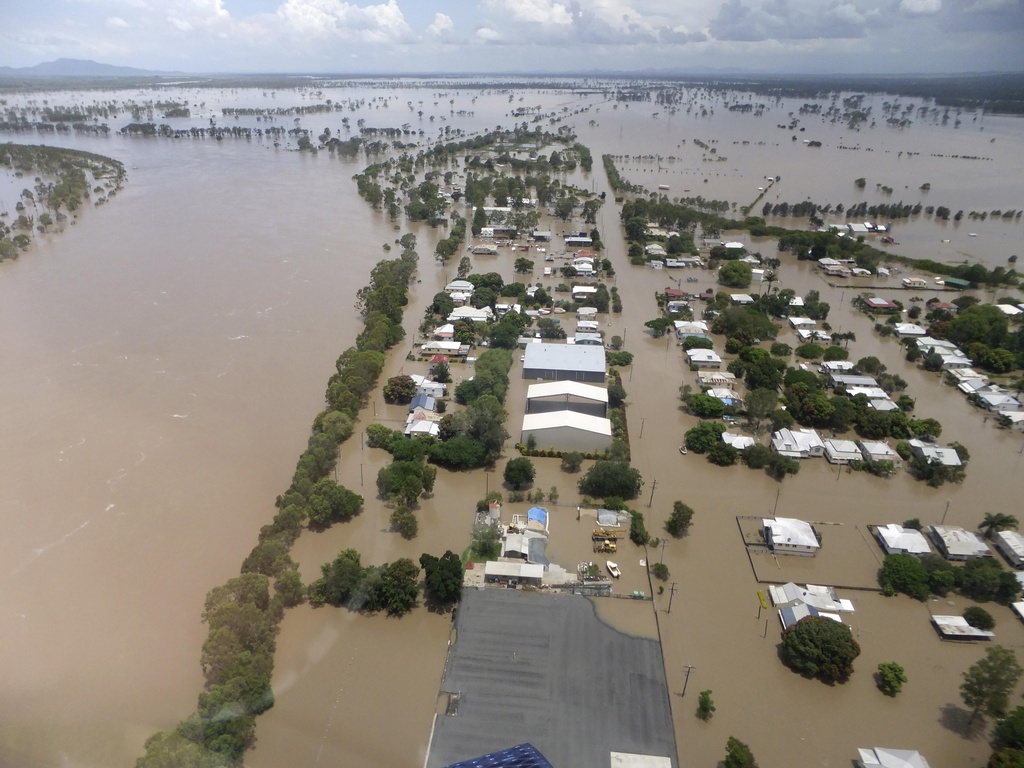“You can only watch as the water rises”

More than 200,000 people in 40 communities across the state of Queensland - an area the size of Germany and France - have been hit by Australia's record floods.
Two Swiss nationals living in Australia told swissinfo.ch what was happening in their affected regions.
The unprecedented flooding has left towns virtual islands in a muddy inland sea, devastated crops, cut major rail and road links to coal ports, slashed exports and forced up world coal prices.
Swiss-Australian Rolf Hauert lives with his wife and child in the waterlogged city of Rockhampton on the northeastern coast.
Hauert runs a chiropractor’s clinic, which is not yet under water.
“But a few metres down the road you can already see the water,” he explained.
“It looks like we will be lucky and the clinic shouldn’t be too affected even if the river swells to its peak on Wednesday of 9.4 metres – 20cm higher than today.”
In some parts of the city everything feels normal, he explained.
“People are shopping, the stores are open but in other parts you can only get to the houses using a boat.”
No panic
Many people have been evacuated, but there is no sense of panic, he added: “This morning [Tuesday] I went to the supermarket. I was astonished how many things were still for sale. Some shelves were quite empty, such as fresh produce like cheese and yogurts. But the milk shelf was completely full.”
People were more panicky a week ago when the warning went out about high floodwaters, but the people of Rockhampton are quite calm as the catastrophic floods were expected, he said.
“We knew what was coming about one week ago. The funny thing it is that you know what’s coming but you can’t really do anything. You can only prepare a little. We got some sandbags ready, but you can’t really do much, you can only watch as the water rises.”
“A place was opened at the university where people could be evacuated. But two days ago there were only about 60 people there. The rest are staying with family and friends.”
The situation in the city is not as dramatic as in the surrounding countryside, he said, adding that the authorities were doing a good job.
Mobilisation
“Special relief units have been mobilised similar to the Swiss civil defence force. But they don’t have the kind of civil protection facilities that exist in Switzerland.”
But the organisation is going well, he added: “A few days ago a plan was published on the internet that showed which streets would probably be flooded. We feel quite safe.”
The Australian army has also been mobilised to fly in food and medical supplies by helicopter to cut-off locations.
But the price tag for the damage to ruined crops, lucrative coal mines and state infrastructure is expected to run into billions of dollars.
“Seventy-five per cent of our mines are currently not operating because of this flood, so that’s a massive impact on the international markets and the international manufacture of steel,” Queensland Premier Anna Bligh told local television.
Standstill
Most of the mining facilities are located inland, explained Daniel Gschwind, the Swiss honorary consul for Brisbane and head of the Queensland tourist office, who has lived in Australia for 25 years.
“The transport systems are also affected. Coal and ore are generally taken by rail to the coast for shipment. But everything has pretty much come to a standstill.”
After a ten-year-long drought, crops had just started to yield normal harvests, but they too have taken a battering.
“And many streets were damaged by the rains even before the flooding. It will take a long time before we recover from this disaster,” said Hauert.
But the Australians are resilient, he added: “They are tough people. I don’t think they have been devastated by the storm. People here are used to having to look after themselves. They make the most out of things.”
The social support network is less strong than in Switzerland, but the state is offering loans to affected farmers and small enterprises, said Hauert.
The Australian floods have been caused by a “La Nina” weather pattern, which produces monsoonal rains over the western Pacific and Southeast Asia.
The La Nina saw Australia record its third wettest year on record in 2010 and is expected to last another three months, the nation’s weather bureau said on Wednesday.
With more than 200,000 people affected across Queensland, a state cabinet meeting is expected to address the response to the flooding.
“Given the scale and size of this disaster and the prospect that we’ll see waters sitting for potentially a couple of weeks… we will continue to have major issues to deal with throughout January,” said state Premier Anna Bligh. “The long-term impact will still take some time to determine but there are literally thousands of Queenslanders who need our support.”
The United Nations has said that Secretary-General Ban Ki-moon was watching the situation “with growing alarm”, although Australia had not made any request for assistance.
(Translated from German by Simon Bradley)

In compliance with the JTI standards
More: SWI swissinfo.ch certified by the Journalism Trust Initiative













You can find an overview of ongoing debates with our journalists here . Please join us!
If you want to start a conversation about a topic raised in this article or want to report factual errors, email us at english@swissinfo.ch.